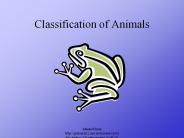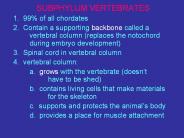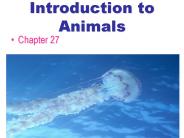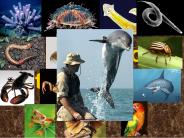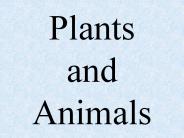Vertebrates Animals PowerPoint PPT Presentations
All Time
Recommended
Animals = invertebrates and vertebrates (95% of all animals are invertebrates) Animal Characteristics The bodies of animals are multicellular.
| PowerPoint PPT presentation | free to view
Kinds of animals with backbone. Mammal, Bird, Fish, Amphibians, and Reptiles are examples of Vertebrates Animals. Science for Primary
| PowerPoint PPT presentation | free to download
KINGDOM ANIMALIA Characteristics of Animals 5. Segmentation Segmentation refers to the repetition of body parts that contain similar structures along the length of ...
| PowerPoint PPT presentation | free to view
KINGDOM ANIMALIA General Characteristics of Animals KINGDOM ANIMALIA: 10 PHYLA Porifera Cnidaria Rotifera Platyhelminthes Nematoda Annelida Mollusca Arthropoda ...
| PowerPoint PPT presentation | free to view
Vertebrates Stephanie Johns Definition of Vertebrates organisms with many cells heterotrophic endothermic or ectothermic Characteristics of Vertebrates Backbones ...
| PowerPoint PPT presentation | free to view
Title: Animal Survival Author: Betty Alspaugh Last modified by: Richard Hughes Created Date: 10/16/2006 11:39:10 PM Document presentation format: On-screen Show (4:3)
| PowerPoint PPT presentation | free to download
Arthropods are different from all other animals because they are eucoelomates with a hard, segmented body. The phylum Arthropoda (jointed-foot) consists of most of ...
| PowerPoint PPT presentation | free to download
... animals by the way they look, the sounds they make, or the tracks or other signs ... Biodiversity. Habitats. Animal Tracks and Other Sign. Animal Photos ...
| PowerPoint PPT presentation | free to download
Vertebrates There are five groups of vertebrates. Vertebrates are animals with backbones. Birds Have feathers and wings Hatch from eggs Fish Live in water Most fish ...
| PowerPoint PPT presentation | free to download
Animals Vertebrates Vertebrates Five Classes Endoskeleton Support Protect Attachment Notochord Five Classes Fish Amphibians Reptiles Birds Mammals Fish Live in water ...
| PowerPoint PPT presentation | free to download
Vertebrates Animals with backbones * * * * * * There are 5 vertebrate groups Amphibians (frogs and newts) Reptiles - (lizards and snakes) Fish Birds Mammals ...
| PowerPoint PPT presentation | free to view
You will be learning about two main classifications of animals: Vertebrates, invertebrates, and the ... and rasping teeth. There are two main types: Lampreys ...
| PowerPoint PPT presentation | free to view
Vertebrates. Animals with backbones. There are 5 vertebrate ... Dolphin - skeleton. Dinosaur fossil skeleton. X ray of rat. X-ray of lizard. X-ray - Frog ...
| PowerPoint PPT presentation | free to download
Complex Animals
- Complex Animals Animals are spilt into two major groups: Vertebrates Invertebrates
Complex Animals Animals are spilt into two major groups: Vertebrates Invertebrates
| PowerPoint PPT presentation | free to view
Vertebrates & Invertebrates Interactive Presentation designed by Mr. Phillips July 2004
| PowerPoint PPT presentation | free to download
Porifera & Cnidarians - chs.helenaschools.org ... Animals
| PowerPoint PPT presentation | free to view
Vertebrates Lungfishes Classes of Chordates Tetrapods Classes of Tetrapods Amphibians Urodela ( tailed ones ) Salamanders Anura ( tailless ones ) Frogs and ...
| PowerPoint PPT presentation | free to download
Vertebrates Linnea Kirby, Michelle Duffy, and Adrienne Vergith-Hill
| PowerPoint PPT presentation | free to view
Vertebrates 3.3.7.A Describe the similarities and differences that characterize diverse living things; describe how the structures of living things help them function ...
| PowerPoint PPT presentation | free to view
Vertebrates are Animals with a backbone Chordate What are they- An animal that has, for al least some stage of its life, a dorsal hollow nerve cord; a notochord ...
| PowerPoint PPT presentation | free to view
Gnathostomes Vertebrates with jaws. Derived Characters Jaws Duplication of Hox genes: Gave rise to larger brains, enhancing smell and vision.
| PowerPoint PPT presentation | free to download
INTRODUCTION TO ANIMALS Chapter 34 Animal Basics 4 Defining Characteristics Morphology (animal bodies) Invertebrates versus vertebrates Morphology Symmetry Radial ...
| PowerPoint PPT presentation | free to download
Vertebrates / Invertebrates Brandi Nunn Peach County Schools STANDARD S5L1a. Demonstrate how animals are sorted into groups (vertebrate and invertebrate) and how ...
| PowerPoint PPT presentation | free to view
Heterotrophs - Cannot make their own food, must get energy by eating plants or other ... Endothermic animals must eat much more often than an ectodermic animal. ...
| PowerPoint PPT presentation | free to view
... some have a 4 chambered heart Vertebrates Vertebrata Reptiles Vertebrates Vertebrata Aves *endothermic* covered in feathers lay eggs (hard ...
| PowerPoint PPT presentation | free to download
Non-Vertebrates Period 5 Umer Khan James Trimble
| PowerPoint PPT presentation | free to view
Classification of Animals Animals With Backbones Animals with backbones are called vertebrates. Vertebrates include many different kinds of animals.
| PowerPoint PPT presentation | free to download
Comparing Vertebrates The Chordates A chordate is an animal that has, for at least some stage of its life, a dorsal, hollow nerve cord; a notochord; pharyngeal ...
| PowerPoint PPT presentation | free to view
Vertebrates: Introduction A: Classification all belong to Phylum Chordata B: Shared Characteristics Have a backbone encases/protects the dorsal nerve cord (spine ...
| PowerPoint PPT presentation | free to download
The Vertebrates Vertebrate Characteristics Vertebrae (backbone) Notochord (flexible dorsal rod) Nerve cord (hollow) with brain Three layers of cells as an embryo ...
| PowerPoint PPT presentation | free to view
SUBPHYLUM VERTEBRATES 1. 99% of all chordates 2. Contain a supporting backbone called a vertebral column (replaces the notochord during embryo development)
| PowerPoint PPT presentation | free to download
Echinoderms: Spiny-skinned animals Section 31.1 Animal Development Echinoderms are related to vertebrates due to their early development The gastrula is the early ...
| PowerPoint PPT presentation | free to view
Vertebrate Animals Highlight what is BOLD/UNDERLINED DOMAIN- Eukarya KINGDOM- Animalia PHYLUM- Chordata SUBPHYLUM- Vertebrata CLASS- 7 different ORDERS- 10 Placental ...
| PowerPoint PPT presentation | free to download
Many vertebrates, or animals with backbones, have teeth inside their mouths. Teeth are hard, bony structures that grow from the jawbone. ...
| PowerPoint PPT presentation | free to view
The cells of most animals are organized into higher levels of structure, ... substrate (often referred to as a sessile lifestyle, sort of like couch potatoes) ...
| PowerPoint PPT presentation | free to view
Introduction to animals Introduction to Animals
| PowerPoint PPT presentation | free to view
Chapter #7 Simple Animals Chapter 7.1 Notes Traits of Animals Animals can not make food Most animals can move from place to place. Animals have many cells.
| PowerPoint PPT presentation | free to view
Copy URL : gooread.fileunlimited.club/pwaug/0123750601 | The Dissection of Vertebrates 2nd Edition
| PowerPoint PPT presentation | free to download
Animals: The Invertebrates Chapter 23
| PowerPoint PPT presentation | free to view
History of Vertebrates Ch. 20
| PowerPoint PPT presentation | free to view
In the reading, Classifying Animals, we ll look at how and why animals are classified into . ... Some lay eggs in water. Department of Mathematics and Science.
| PowerPoint PPT presentation | free to view
Vertebrate Animals Highlight what is BOLD/UNDERLINED DOMAIN- Eukarya KINGDOM- Animalia PHYLUM- Chordata SUBPHYLUM- Vertebrata CLASS- 7 different ORDERS- 10 Placental ...
| PowerPoint PPT presentation | free to download
Introduction to Animals Chapter 27
| PowerPoint PPT presentation | free to download
Chapter 30-32 Nonvertebrate Chordates, Fishes & Amphibians Reptiles & Birds Mammals Unit 9--Vertebrates
| PowerPoint PPT presentation | free to download
The Kingdom ANIMALS Eukaryotic cells Multicellular Heterotrophic by ingestion External Fertilization vs Internal Fertilization a. Invertebrate Chordates: Tunicates ...
| PowerPoint PPT presentation | free to view
Evolution of Vertebrates Chapter 19
| PowerPoint PPT presentation | free to view
Acoelomate Bilateral Animals Acoelomate Bilateral Animals Consist of phyla: Phylum Platyhelminthes Phylum Nemertea And others Acoelomate Bilateral Animals Simplest ...
| PowerPoint PPT presentation | free to download
Animal Kingdom Vertebrates Biology 1
| PowerPoint PPT presentation | free to download
Chordates and Vertebrates At one time in their development ALL chordates have: Notochord flexible, rod-like structure along the back of the organism
| PowerPoint PPT presentation | free to download
Introduction to Animals Essential Questions: What makes an animal an animal? How are animals classified? Kingdom Animalia Eukaryotic Heterotrophic Multicellular ...
| PowerPoint PPT presentation | free to view
Introduction to Animals To be an animal means Multicellular humans have ~ 50 - 100 trillion cells Ingestive heterotroph Lacking a cell wall Specialization of ...
| PowerPoint PPT presentation | free to download
Amphibians: the First Terrestrial Vertebrates The Two Orders of Amphibians Kingdom Animalia Phylum Chordata Class Amphibia Order Caudata Kingdom ...
| PowerPoint PPT presentation | free to download
Plants and Animals Questions E. How are plants and animals similar and different? U1. What do we know about plants? A. What is a plant? B.
| PowerPoint PPT presentation | free to download
Circulatory System in Animals
| PowerPoint PPT presentation | free to view
Deuterostomate Animals
| PowerPoint PPT presentation | free to view
Animals, Part I Invertebrates Introduction to Animals (Chapter 34) Sponges and Jellyfish (Chapter 35) Simple Worms (Chapter 36) Mollusks and Annelids (Chapter 37)
| PowerPoint PPT presentation | free to view



























